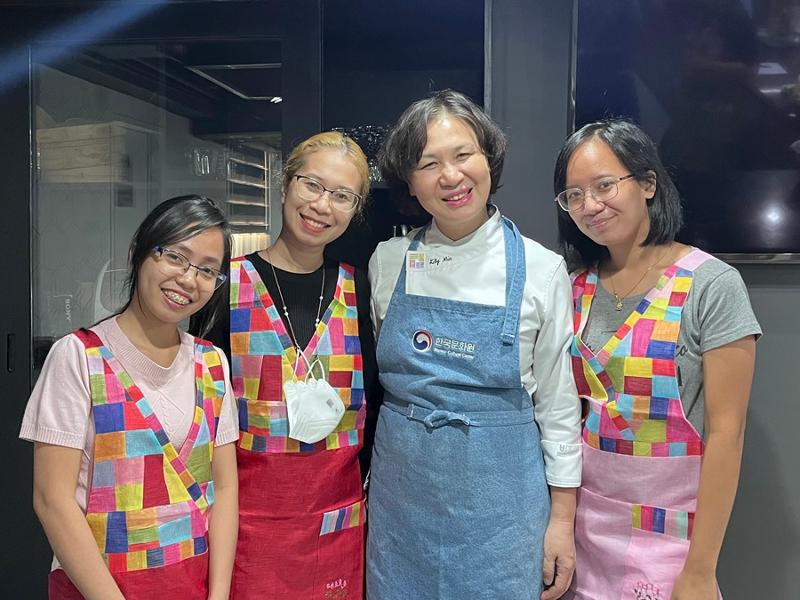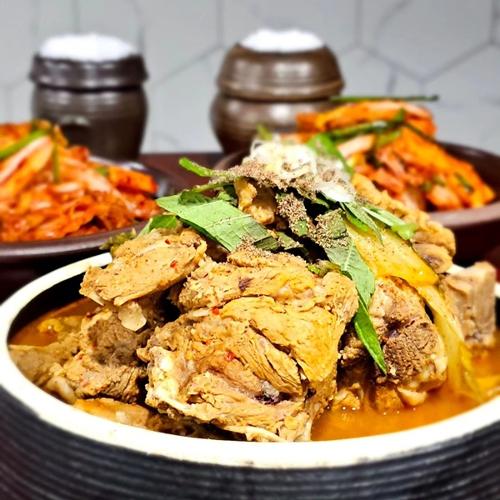- 한국어
- English
- 日本語
- 中文
- العربية
- Español
- Français
- Deutsch
- Pусский
- Tiếng Việt
- Indonesian
By Honorary Reporter Myrtle Iris Villaraza from Philippines
Chef Lily Min is an important bridge between Korea and the Philippines as an instructor in Hansik (traditional cooking) at the Korean Cultural Center (KCC) in Taguig, Metro Manila. A Korean national, Min is a renowned Korean cuisine specialist working in the Philippines.
I first saw her in 2020 on "Hansik Sessions," an online cooking show produced by the KCC. On March 9 this year, the center invited Honorary Reporters like myself to a class on cooking Korean dishes using Philippine ingredients, and this is where I met the chef in person.
I thoroughly enjoyed her class and learned a lot. Min said her class taught Filipinos to make and enjoy Korean food using non-Korean ingredients if they lack access to Korean seasonings such as gochujang (red chili paste) and doenjang (soybean paste).

Chef Lily Min (second from right) poses with Honorary Reporters on March 9 after holding a Korean cooking class at the Korean Cultural Center (KCC) in Taguig, Metro Manila. (Myrtle Iris Villaraza)
She has written Korean cookbooks, appeared on a Philippine cooking show and visited Colombia to teach Korean cuisine to gastronomy majors at the University of La Sabana.
The following are excerpts from a written interview with her between Aug. 28 and Oct. 16.
How long have you been teaching Korean cuisine?
My first job began in 1990 when I taught home education to cyber high school students in Korea after finishing university. I had a little break in the middle due to childbirth and immigration to the Philippines, but 26 years have passed since I started teaching cooking in 1997. I began teaching Korean cuisine here from 2013.
Why did you decide to become a Korean cuisine specialist and instructor?
As a child, I made a simple dish for my parents and got a lot of compliments. I discovered how cooking could give people pleasure. From then on, I dreamed of cooking. In Korea, I managed a cooking studio and taught international cuisines, but after majoring in traditional dietary culture in graduate school, I moved to the Philippines and began teaching Korean food exclusively.
How did you start working with the KCC in Taguig?
I've been a judge at the KCC's Korean Food Contest since the event began in 2014, and this led to me teaching Korean food there from 2017.

Chef Lily Min poses with her first batch of students in the third term of her cooking class this year at the KCC in Taguig. (Lily Min)
What do you think makes Korean food unique from other cuisines?
Health is the basis of Korean food, which is a comprehensive art with a story about the historical background of the human body and food, and takes color into account.
In Korea, obangsaek refers to the five colors of blue, white, black, red and yellow each representing five directions (east, west, north, south and center), five elements (wood, metal, water, fire and earth) and important bodily organs (liver, lung, kidney, heart and stomach). Korean cuisine stresses that food have these five colors. If cooked food has three of them, the other two are added as garnishes.
What challenges have you had in your work?
The process of introducing Korean food based on the Philippine situation isn't easy. It's important to know the cultural situation, supply and demand of ingredients, and difference in culinary preferences to present food well-suited for locals.

Gamjatang (pork bone soup) and mat kimchi (cut cabbage kimchi) are two of many Hansik dishes made by chef Lily Min as a Korean food instructor for the KCC in Taguig. (Lily Min)
Aside from kimchi, what food do you feel best represents Korea and why?
It's difficult to choose what Korean foods as representative foods. If people understand the basics of Hansik and how it developed according to culture and environment to emerge as healthy food, I think they can enjoy all Korean food.
How does the situation in the Philippines affect your teaching of Korean cooking?
You must know the culture of the host country and what types of food locals avoid or prefer. Also, the necessary ingredients could abruptly be unavailable due to the climate and weather or problems in importing them from Korea. So I'm always nervous about getting the right ingredients for my classes or events.
msjeon22@korea.kr
*This article is written by a Korea.net Honorary Reporter. Our group of Honorary Reporters are from all around the world, and they share with Korea.net their love and passion for all things Korean.
Most popular
- Military discharge sets stage for reunion of all 7 BTS members
- BTS to mark 12th anniversary of debut with 2-week festival
- Lee Jae-myung officially sworn in as nation's 21st president
- Presidents Lee, Trump discuss tariff deal in first phone talks
- President's 1st executive order is launch of economic task force
